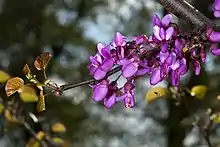Cercidoideae
Cercidoideae is a subfamily in the pea family, Fabaceae. Well-known members include Cercis (redbuds), including species widely cultivated as ornamental trees in the United States and Europe, Bauhinia, widely cultivated as an ornamental tree in tropical Asia, and Tylosema esculentum (Marama bean), a traditional food crop in Africa. The subfamily occupies a basal position within the Fabaceae and is supported as monophyletic in many molecular phylogenies.[2][3][4][5][6][7] At the 6th International Legume Conference, the Legume Phylogeny Working Group proposed elevating the tribe Cercidae to the level of subfamily within the Leguminosae (Fabaceae).[8] The consensus agreed to the change, which was fully implemented in 2017.[1] It has the following clade-based definition:
The most inclusive crown clade containing Cercis canadensis L. and Bauhinia divaricata L. but not Poeppigia procera C.Presl, Duparquetia orchidacea Baill., or Bobgunnia fistuloides (Harms) J.H.Kirkbr. & Wiersema.[1]
| Cercidoideae | |
|---|---|
 | |
| Cercis siliquastrum | |
_in_Hyderabad%252C_AP_W_IMG_1463.jpg.webp) | |
| Phanera variegata | |
| Scientific classification | |
| Kingdom: | Plantae |
| Clade: | Tracheophytes |
| Clade: | Angiosperms |
| Clade: | Eudicots |
| Clade: | Rosids |
| Order: | Fabales |
| Family: | Fabaceae |
| Subfamily: | Cercidoideae Legume Phylogeny Working Group[1] |
| Type genus | |
| Cercis L. | |
| Genera | |
|
See text | |
| Synonyms | |
| |
Many genera show unique palynology.[9][10]
Genera
Cercidoideae comprises the following genera[1][11][12] organized into tribes:[13]
Cercideae
- Adenolobus (Harv. ex Benth. & Hook.f.) Torre & Hillc.
- Cercis L.
- Griffonia Baill.
Bauhinieae
- Barklya F. Muell.
- Bauhinia L.
- Brenierea Humbert
- Cheniella R.Clark & Mackinder[14]
- Gigasiphon Drake
- Lasiobema (Korth.) Miq.[Note 1]
- Lysiphyllum (Benth.) deWit
- Phanera Lour.
- Piliostigma Hochst.
- Schnella Raddi
- Tylosema (Schweinf.) Torre & Hillc.
Phylogeny
Molecular phylogenetics suggest the following relationships:[11][13][14][16]
| Fabales |
| ||||||||||||||||||||||||||||||||||||||||||||||||||||||||||||||||||||||||||||||||||||
Notes
- Some sources treat Lasiobema as a synonym of Phanera.
References
- The Legume Phylogeny Working Group (LPWG). (2017). "A new subfamily classification of the Leguminosae based on a taxonomically comprehensive phylogeny". Taxon. 66 (1): 44–77. doi:10.12705/661.3.
- Doyle JJ, Chappill JA, Bailey CD, Kajita T (2000). "Towards a comprehensive phylogeny of legumes: Evidence from rbcL sequences and non-molecular data". In Herendeen PS, Bruneau A (eds.). Advances in Legume Systematics, Part 9. Kew, UK: Royal Botanic Gardens. pp. 1–20. ISBN 184246017X.
- Bruneau A, Forest F, Herendeen PS, Klitgaard BB, Lewis GP (2001). "Phylogenetic Relationships in the Caesalpinioideae (Leguminosae) as Inferred from Chloroplast trnL Intron Sequences". Syst Bot. 26 (3): 487–514. doi:10.1043/0363-6445-26.3.487 (inactive 2021-01-17).CS1 maint: DOI inactive as of January 2021 (link)
- Davis CC, Fritsch PW, Li J, Donoghue MJ (2002). "Phylogeny and Biogeography of Cercis (Fabaceae): Evidence from Nuclear Ribosomal ITS and Chloroplast ndhF Sequence Data". Syst Bot. 27 (2): 289–302. doi:10.1043/0363-6445-27.2.289 (inactive 2021-01-17).CS1 maint: DOI inactive as of January 2021 (link)
- Wojciechowski MF, Lavin M, Sanderson MJ (2004). "A phylogeny of legumes (Leguminosae) based on analysis of the plastid matK gene resolves many well-supported subclades within the family". Am J Bot. 91 (11): 1846–62. doi:10.3732/ajb.91.11.1846. PMID 21652332. S2CID 13934619.
- Bruneau A, Mercure M, Lewis GP, Herendeen PS (2008). "Phylogenetic patterns and diversification in the caesalpinioid legumes". Botany. 86 (7): 697–718. doi:10.1139/b08-058.
- LPWG [Legume Phylogeny Working Group] (2013). "Legume phylogeny and classification in the 21st century: progress, prospects and lessons for other species-rich clades" (PDF). Taxon. 62 (2): 217–248. doi:10.12705/622.8.
- LPWG [Legume Phylogeny Working Group] (2013). "Towards a new classification system for legumes: Progress report from the 6th International Legume Conference". S Afr J Bot. 89: 3–9. doi:10.1016/j.sajb.2013.07.022.
- Banks H, Forest F, Lewis GP (2013). "Palynological contribution to the systematics and taxonomy of Bauhinia s.l. (Leguminosae: Cercideae)". South African Journal of Botany. 89: 219–226. doi:10.1016/j.sajb.2013.07.028.
- Banks H, Forest F, Lewis GP (2014). "Evolution and diversity of pollen morphology in tribe Cercideae (Leguminosae)". Taxon. 63 (2): 299–314. doi:10.12705/632.37.
- Sinou C, Forest F, Lewis GP, Bruneau A (2009). "The genus Bauhinia s.l. (Leguminosae): A phylogeny based on the plastid trnL–trnF region". Botany. 87 (10): 947–960. doi:10.1139/B09-065.
- Wunderlin RP (2010). "Reorganization of the Cercideae (Fabaceae: Caesalpinioideae)" (PDF). Phytoneuron. 48: 1–5.
- Wunderlin RP (2010). "Reorganization of the Cercideae (Fabaceae: Caesalpinioideae)" (PDF). Phytoneuron. 48: 1–5.
- Clark RP, Mackinder BA, Banks H. (2017). "Cheniella gen. nov. (Leguminosae: Cercidoideae) from southern China, Indochina and Malesia". European Journal of Taxonomy. 360 (360): 1–37. doi:10.5852/ejt.2017.360.CS1 maint: uses authors parameter (link)
- Calvillo-Canadell L, Cevallos-Ferriz SR (2002). "Bauhcis moranii gen. et sp. nov. (Cercideae, Caesalpinieae), an Oligocene plant from Tepexi de Rodríguez, Puebla, Mex., with leaf architecture similar to Bauhinia and Cercis". Rev Palaeobot Palynol. 122 (3–4): 171–184. doi:10.1016/S0034-6667(02)00135-5.
- Wang Y-H, Wicke S, Wang H, Jin J-J, Chen S-Y, Zhang S-D, Li D-Z, Yi T-S. (2018). "Plastid Genome Evolution in the Early-Diverging Legume Subfamily Cercidoideae (Fabaceae)". Frontiers in Plant Science. 138 (138): 1–12. doi:10.3389/fpls.2018.00138. PMC 5812350. PMID 29479365.CS1 maint: uses authors parameter (link)
External links
 Data related to Cercidoideae at Wikispecies
Data related to Cercidoideae at Wikispecies

